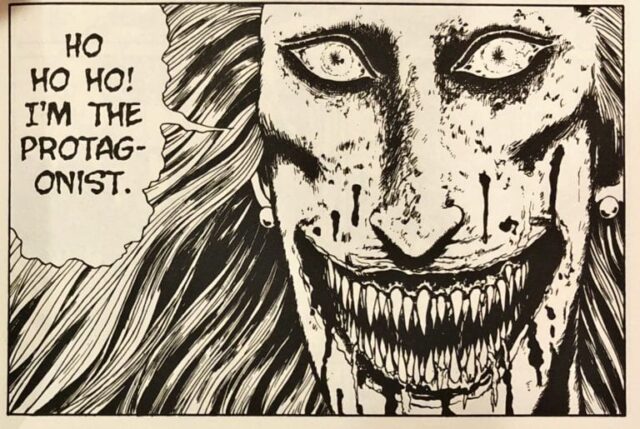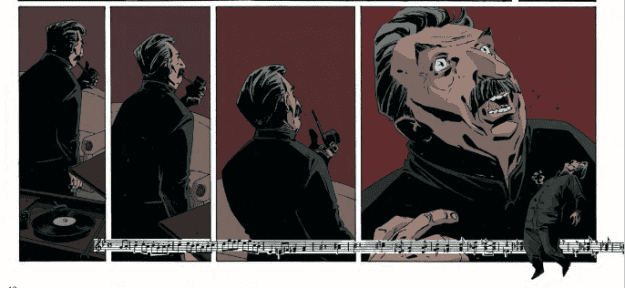Today on the site, editor Mike Catron explains what exactly went into the new edition of Bhob Stewart's tribute book, The Life and Legend of Wallace Wood.
Bhob Stewart, who originally began this project for Fantagraphics, ultimately came to regard the version of it that saw print from a different publisher as a profound and bitter disappointment.
Despite the fact that it was well received at the time, Bhob cringed at the mediocre paper, the less-than-stellar reproduction, and the cheap binding. (Pages are literally falling out of my softcover copy.) But most of all — the thing that made him grind his teeth the hardest — was the censoring of Wallace Wood’s art. Bhob never got over that.
The other publisher required him to go through all of Wood’s art and delete anything the publisher felt was improper. Particular words had to be deleted or printed with asterisks, even when part of a direct quote. He was allowed to print semi-nude figures, but only if certain body parts were whited out — even when only shown in silhouette. Some of the Wood art he wanted to use was summarily rejected outright as unredeemable, and he had to scramble to find innocuous replacements that weren’t even relevant. This was especially evident in a chapter devoted to Wood’s infamous “Disneyland Memorial Orgy”. It offered some amusing panels poking fun at Disney characters that Wood had drawn for Mad magazine — but nothing at all from the “Orgy”, which was the subject of the discussion.
In another instance, Bhob had cleverly reconstructed an EC “prank page” in which Wood drew a nude female figure. It was so heavily censored that readers rightly wondered what all the fuss was about. (To set things right, an undaunted Bhob wrote an essay explaining the whole muddle. We re-reconstructed the prank and that became a new chapter in Volume 1.)
It was ridiculous. It was appalling. It was a desecration. But Bhob had signed a contract, and he felt he was stuck.
We also have Judy Berman's review of a comic with a very odd high concept: Derek Marks's Grace, Jerry, Jessica and Me.
Some historical convergences demand fanfiction. My own personal canon includes the first Redstockings meeting; the drafting of the Dogme 95 manifesto and “Vow of Chastity”; any given night at Zurich’s Cabaret Voltaire; Britpop’s Damon Albarn-Justine Frischmann-Brett Anderson love triangle; and the day Poly Styrene, Debbie Harry, Viv Albertine, Siouxsie Sue, Chrissie Hynde and Pauline Black all got together for a class picture. For Derek Marks, nothing tops that time in the ‘70s when Grace Jones, Jerry Hall and Jessica Lange were roommates in Paris.
Like most great 21st-century discoveries, this factoid came to Marks, a New York-based cartoonist and illustrator who was once “a tragic gay teen goth” in Miami, via the internet. The first issue of his hilarious comic Grace, Jerry, Jessica and Me, from 2014, opens with the author stumbling out of a “Google hole” (wow, relatable) with the wondrous revelation clutched in his hot little hand. “The trio’s potential fabulousness blew me so far away,” he writes, “I found I had time-traveled to Paris and landed as their fourth roommate.”
Meanwhile, elsewhere:
—Reviews & Commentary. BoingBoing has excerpted the introduction Lynn Johnston wrote for the first volume of the collected For Better or For Worse.
When I was barely 20 years old, I got married. My husband and I settled into an old apartment in Vancouver, near English Bay. He was working for the CBC as a cameraman and I was an ink and paint artist for Canawest Films. I wanted to be an animator and was learning the industry from the ground up. We did commercials, public service announcements and piece work for Hanna Barbera. I was one of 16 young women hired to hand colour acetate cells. Having signed an agreement to not join a union, we took shifts and worked around the clock for $1.50 an hour. It was hard work, but I learned quickly and I realized that an animator makes other people's drawings, other people's characters, other people's dreams come to life. With no children to occupy my time at home, I decided to try my hand at creating stories and characters of my own. I have always been more at home with realistic scenarios, so I decided to tell short stories about my childhood. Within a few weeks, I had a few tall tales worked out and perhaps, 15 coloured drawings. I wondered if they might even be published some day. It was 1968 and I was creating a graphic novel.
For the New York Review of Books, Dash Shaw reviews Paul Karasik and Mark Newgarden's How to Read Nancy.
One of the defining traits of 1980s New York City postmodernist writing and painting was the urge to deconstruct. This extended to the comics medium in Art Spiegelman and Francois Mouly’s Raw, an oversized anthology magazine that serialized Maus and introduced readers to “art comics” from around the world. Spiegelman’s experimental work looked like exploded pages of Sunday cartoon battles between what was then considered “low” and “high” art. Richard McGuire’s short story “Here” dissected a single room across time using a panel-in-panel device also seen in 1980s painters like David Salle and Robert Longo. Gary Panter drew apocalyptic nightmares that dismantled and intuitively reconstructed drawing modes from Picasso to Jack Kirby.
In the midst of all of this deconstruction was a renewed interest among cartoonists in a humble, plain-looking gag strip that began in the 1930s: Ernie Bushmiller’s Nancy. Nancy follows an eight-year-old suburban girl as she solves mundane problems and interacts with Sluggo, a fellow prankster and sometimes romantic interest. Bushmiller (born in 1905) drew it for most of his life, with each strip as a self-contained “gag”—a single joke that could be easily digested as the reader glanced across the strip. The imagery and jokes are so prototypical and simple that the American Heritage Dictionary uses it to illustrate the meaning of “comic strip.” The appeal of Nancy to the art comic crowd might seem counter-intuitive, but while Nancy was never particularly clever, it was always cleverly constructed. In fact, the accomplishment of Nancy, with its refined, reduced lines and preoccupation with plungers and faucets, might primarily be a matter of form. As Bill Griffith (Zippy the Pinhead, also Raw) wrote in his 2012 introduction to a collected Nancy volume: “Nancy doesn’t tell us much about what it’s like to be a kid. What Nancy tells us is what it’s like to be a comic strip.”
At LARB, Jackson Ayres reviews Saladin Ahmed and Christian Ward's Black Bolt.
Ahmed’s Black Bolt, then, springs from these two interlocked narrative and extraliterary developments: Marvel’s positioning of the Inhumans as cornerstones of their line-wide continuity, and the company’s push, via live-action adaptations, for broader public recognition of the franchise. Unfortunately the Inhumans television series debuted to some of the first truly bad reviews for the franchise since its 2008 launch in the first Iron Man movie. But the coup of hiring Ahmed, an acclaimed writer of prose SF and fantasy, to helm Black Bolt no doubt helped to introduce the character to those who may not previously have heard of him.
After a too-long absence, Janean Patience returns with a very long piece on the 1980s work of Howard Chaykin.
Because we like to arrange things in threes, because that’s our pattern, there’s long been a glaring gap in the history of comics. Everyone agrees on two sides of the triangle: Watchmen and Dark Knight, the autopsy and the brass band funeral. But who’s the third? Maus has been most often suggested, even though it was only half-out, came from a very different place than those glossy contemporaries and wasn’t part of the hip, cool graphic novel movement. No, the third of the three, alongside Moore and Miller, was Chaykin. There was only one problem; the work.
Because there is, ultimately, an obvious advantage to being with DC Comics, however they rip you off. Even if it’s how they rip you off: they make your work available. They get it in comics shops and bookshops and airports and all those places, all those disregarded distribution outlets that are the grass roots of the graphic novel revolution, that take it to a wider audience. Without that, without that splash, you can be a key player in the revolution, a pioneer of creative ownership, and nobody will even know.
Back up. American Flagg, the comic Chaykin created, wrote and drew, began monthly publication in 1983. Moore was doing great things in 2000AD and Warrior and preparing to bound across the Atlantic. Miller had concluded his first spell on Daredevil and was writing and drawing Ronin. The revolution was gearing up. Everyone was already doing their creator-owned work alongside or inbetween their work-for-hire; it was a part of comics growing up from the very beginning. But Chaykin was winning. Flagg, published (and, according to the indicia, to some extent co-owned) by First Comics, was a hit right out of the gate. Monthly, independent, sexy, unleashing new ideas and characters and complications with every issue. It tore through its first year, 12 issues of 28 pages telling one overarching story. It was hot and it was Howard’s; a commercial sensibility of colour and design and action brought to that sector of comics previously aligned with the black-and-white fantasy of Cerebus and Elfquest. Everyone knew Flagg. I was like 11 years old and I knew Flagg.
—Interviews & Profiles. The Comics Alternative podcast interviews Ho Che Anderson.































